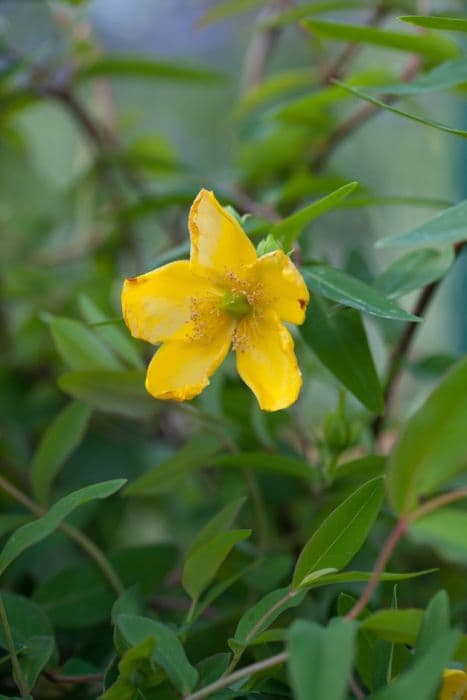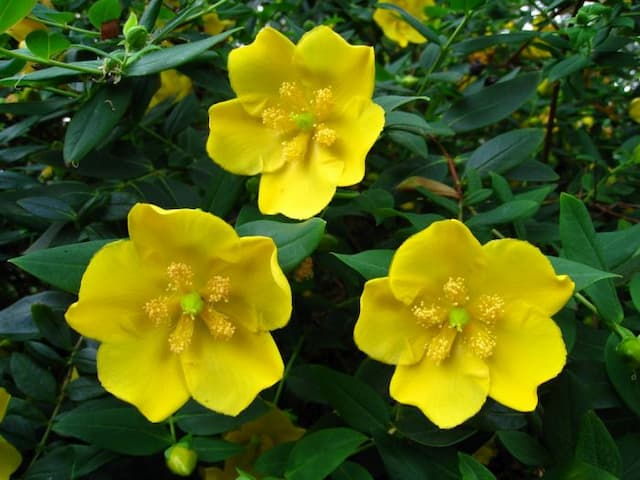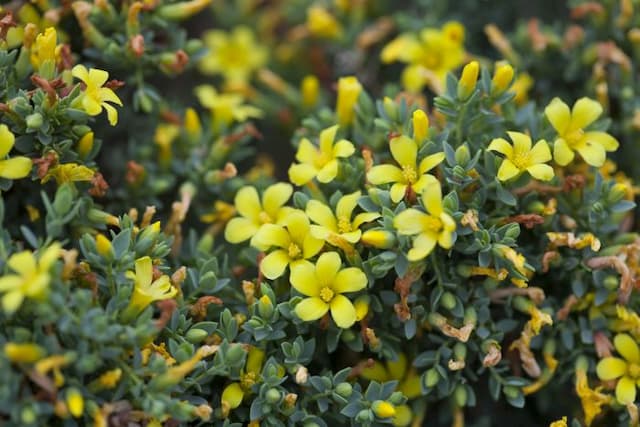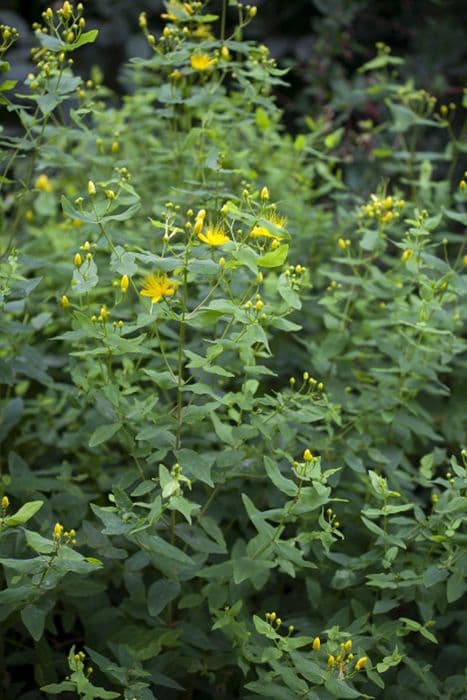St. John's Wort Hypericum Miracle Wonder = 'Hymirwon' (Miracle Series)

ABOUT
Hypericum Miracle Wonder, commonly known as St. John's Wort, boasts a vibrant and appealing appearance. It is characterized by its lush green foliage, which serves as a striking backdrop to its prominent, cheerful flowers. The flowers are typically bright yellow, with an abundance of stamen-like structures erupting from the center, giving them a fluffy, almost fireworks-like quality. They bloom generously throughout the summer months, providing a long-lasting display of color in the garden. The glossy leaves of the St. John's Wort are oblong and may have a slightly blue or grayish tint, adding to the plant's ornamental value. Additionally, the plant may produce reddish-colored, berry-like fruits that add an extra visual interest as the flowering season ends. This combination of features makes the Hypericum Miracle Wonder a favored choice for gardeners looking to add a pop of color and texture to their landscapes.
About this plant
 Names
NamesFamily
Hypericaceae
Synonyms
St. John's Wort, Hypericum
Common names
Hypericum 'Hymirwon'.
 Toxicity
ToxicityTo humans
The Hypericum, commonly known as St. John's Wort, can have toxic effects if ingested by humans. While often used for medicinal purposes, particularly for depression, in larger quantities, it may cause adverse reactions. Possible symptoms of poisoning include gastrointestinal distress (e.g., nausea, vomiting, diarrhea), dizziness, confusion, fatigue, and photosensitivity, leading to skin irritation or burns when exposed to sunlight. The plant should be handled with care and consumed only in recommended dosages when used for therapeutic purposes.
To pets
St. John's Wort can be toxic to pets if ingested. The consumption of this plant can result in similar reactions as seen in humans, such as gastrointestinal upset including vomiting and diarrhea. Moreover, there is a risk of photosensitivity, which may cause skin irritation or burns under sunlight exposure, and in rare cases, neurological symptoms such as lethargy, ataxia, or tremors may occur. It is important to prevent pets from accessing this plant to avoid the risk of poisoning.
 Characteristics
CharacteristicsLife cycle
Perennials
Foliage type
Deciduous
Color of leaves
Green
Flower color
Yellow
Height
1-2 feet (30-60 cm)
Spread
1-2 feet (30-60 cm)
Plant type
Shrub
Hardiness zones
5
Native area
Cultivar
Benefits
 General Benefits
General Benefits- Low maintenance: Hypericum 'Hymirwon' requires minimal care once established, making it a suitable choice for gardeners of all levels.
- Attractive flowers: It produces showy yellow flowers that can add a bright splash of color to the garden.
- Drought tolerance: Once established, Hypericum 'Hymirwon' has a good tolerance to dry conditions, reducing the need for frequent watering.
- Winter interest: With its semi-evergreen to evergreen foliage and persistent decorative berries, it offers visual interest even in the colder months.
- Wildlife attraction: The flowers provide nectar for bees and other pollinators, while the berries can attract birds to the garden.
- Disease resistance: It is often resistant to many common plant diseases, ensuring a healthy and robust garden presence.
- Versatile planting: Can be used in a variety of garden settings including borders, rock gardens, or as ground cover.
- Year-round interest: It provides multiple seasons of interest due to its flowering season and attractive berries that often last into winter.
- Aesthetic versatility: Its compact, bushy form and colorful presence make it a suitable plant for various garden designs and container planting.
 Medical Properties
Medical Properties- Antidepressant: Hypericum, commonly known as St. John's Wort, has been studied for its potential to alleviate symptoms of depression.
- Antiviral: Some studies suggest that compounds in Hypericum may possess antiviral properties effective against certain viruses.
- Anti-inflammatory: The plant has been traditionally used for its anti-inflammatory effects, which can help with conditions such as muscle aches and tension.
- Wound healing: Hypericum is sometimes applied topically in certain preparations to promote the healing of minor wounds and burns.
- Anxiolytic: It might have anxiolytic properties, helping reduce anxiety in some individuals.
 Air-purifying Qualities
Air-purifying QualitiesThis plant is not specifically known for air purifying qualities.
 Other Uses
Other Uses- Photography prop: The bright yellow flowers of Hypericum can provide an eye-catching background or an accent in macro photography sessions.
- Dye source: The flowers and berries of Hypericum may be used to create natural dyes for fabrics, yielding shades of yellow, red, or purple depending on the mordant used.
- Crafts: The woody stems and dried flowers of Hypericum can be incorporated into wreaths and other dried floral arrangements.
- Garden design: Due to its compact growth habit, Hypericum is suitable for use in rock gardens or as low hedging in landscape designs.
- Erosion control: The dense growth of Hypericum can help stabilize soil in areas prone to erosion.
- Potpourri ingredient: The fragrant leaves and dried berries of Hypericum can be included in potpourri mixes to add texture and scent.
- Lucky charm: In some cultures, carrying a sprig of Hypericum is considered to bring good luck or ward off evil spirits.
- Art supplies: The stems and flowers can be used by children and artists alike for creating natural stamps or as embellishments in papermaking.
- Insect repellent: Some people use Hypericum in bouquets to deter insects naturally without chemicals.
- Theme gardens: Hypericum's bright flowers and berries make it suitable for a 'sunshine' themed garden that focuses on plants with yellow blooms.
Interesting Facts
 Feng Shui
Feng ShuiSt. John's Wort is not used in Feng Shui practice.
 Zodiac Sign Compitability
Zodiac Sign CompitabilitySt. John's Wort is not used in astrology practice.
 Plant Symbolism
Plant Symbolism- Protection: Hypericum is often associated with protection from evil spirits and negative energies in folklore.
- Healing and Medicine: The plant has been used historically in herbal medicine, suggesting symbols of health and recovery.
- Happiness and Good Cheer: As the common name "St. John's Wort" implies, it is traditionally linked to St. John's Day and thought to bring joy and ward off depression.
- Strength and Resilience: It is a hardy plant that can thrive in challenging conditions, symbolizing the ability to persevere through adversity.
 Water
WaterSt. John's Wort needs regular watering, especially during its growing season in the spring and summer. Provide it with about one inch of water per week, taking care not to overwater as this can lead to root rot. The soil should be kept evenly moist but never soggy. In the hot summer months, you may need to water twice a week, and in the cooler months, reduce watering to when the top inch of soil feels dry to the touch. It's best to water this plant in the morning hours to allow any excess water on the foliage to evaporate throughout the day.
 Light
LightSt. John's Wort thrives in full sun to partial shade. The ideal location would provide at least six hours of direct sunlight each day, but it will tolerate some light shade, especially in hotter climates. Too little light may result in fewer flowers and leggy growth, so make sure the plant receives plenty of sunlight for optimum blooming and foliage density.
 Temperature
TemperatureSt. John's Wort prefers temperate climates with temperatures ranging between 50°F and 80°F. However, it can survive temperatures as low as 0°F in winter and as high as 95°F in summer. For best growth and flowering, maintain temperatures within the ideal range and protect the plant from extreme temperature fluctuations which can stress the plant.
 Pruning
PruningPrune St. John's Wort in early spring to shape the plant and remove any dead or damaged branches, which encourages new growth and better flowering. It is often beneficial to cut back about a third of the old wood to maintain a compact form. Pruning can be done annually, as this helps to rejuvenate the plant and keeps it looking tidy.
 Cleaning
CleaningAs needed
 Soil
SoilSt. John's Wort (Hypericum Miracle Wonder) thrives in well-draining soil with a pH between 5.5 and 7. A mix of loamy garden soil, peat, and perlite or sand is ideal to facilitate proper drainage and aeration. Regularly check for waterlogged conditions to prevent root rot.
 Repotting
RepottingSt. John's Wort should be repotted every 2-3 years or when it outgrows its current container. Spring is the best time for repotting to minimize stress on the plant and encourage robust growth in the growing season.
 Humidity & Misting
Humidity & MistingSt. John's Wort prefers moderate humidity levels, generally between 40-60%. While it can tolerate lower humidity, it thrives with a consistent moisture level in the air, avoiding extremes of dryness or dampness.
 Suitable locations
Suitable locationsIndoor
Place St. John's Wort in bright, indirect light indoors.
Outdoor
Full sun to partial shade, shelter from strong winds outdoors.
Hardiness zone
5-9 USDA
 Life cycle
Life cycleThe Hypericum 'Hymirwon', commonly known as Miracle Wonder, begins its life cycle with seed germination under suitable environmental conditions of warmth and moisture. As a young plant, it develops a root system and sprouts its first leaves, entering a vegetative growth phase where it focuses on foliage development. The plant then transitions to the flowering stage, producing its characteristic yellow flowers which, after pollination, develop into berries. The seeds within these berries represent the reproductive phase and can disperse to begin a new cycle when conditions are favorable. After seeds are set, the plant may enter a period of dormancy, particularly in colder climates, during which above-ground growth ceases. Over several years, Miracle Wonder will continue this cycle, with each season potentially leading to increasing growth and spread until it reaches maturity.
 Propogation
PropogationPropogation time
Spring-Early Summer
Propogation: The most popular method of propagating the Hypericum 'Miracle Wonder' is through softwood cuttings. This typically takes place in late spring or early summer, when new growth is soft and pliable but not too mature. To do this, gardeners carefully select healthy, non-flowering shoots and make a cutting of about 4 to 6 inches long (10 to 15 centimeters). The lower leaves are removed, and the cut end is dipped in rooting hormone to encourage root growth. The cutting is then placed in a well-draining soil mix, ensuring that about two-thirds of the cutting is submerged. The container should be kept in a warm place with high humidity and indirect light. Within a few weeks, the cuttings should develop roots and can eventually be transplanted into the garden.









